
Vancouver Island is in the northeastern Pacific Ocean in North America's Pacific Northwest. It is part of Canadian province of British Columbia. The island is 460 kilometres (290 mi) in length, 100 kilometres (62 mi) in width at its widest point, and 32,134 km2 (12,407 sq mi) in area. It is the second largest island on the West Coast of the Americas.
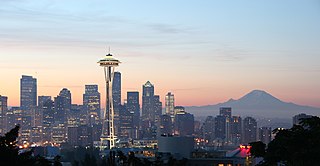
The Pacific Northwest (PNW), sometimes referred to as Cascadia, is a geographic region in western North America bounded by the Pacific Ocean to the west and (loosely) by the Rocky Mountains on the east. Though no official boundary exists, the most common conception includes the Canadian province of British Columbia (BC) and the U.S. states of Idaho, Oregon, and Washington. Broader conceptions reach north into Southeast Alaska and Yukon, south into northern California, and east to the Continental Divide to include Western Montana and parts of Wyoming. Narrower conceptions may be limited to the coastal areas west of the Cascade and Coast mountains. The variety of definitions can be attributed to partially overlapping commonalities of the region's history, culture, geography, society, and other factors.

Battle Ground is a city in Clark County, Washington, United States. The population was 17,571 at the 2010 census. Between 2000 and 2005, Battle Ground ranked fourth in the state for population growth, out of 279 eligible incorporated communities. As of 2018, its population is 20,949.

Camas is a city in Clark County, Washington, with a population of 19,355 at the 2010 census. The east side of town borders the city of Washougal, Washington, and the west side of town borders Vancouver, Washington. Camas lies along the Washington side of the Columbia River, across from Troutdale, Oregon, and is part of the Portland metropolitan area.

New Westminster is a city in the Lower Mainland region of British Columbia, Canada, and a member municipality of Metro Vancouver. It was founded by Major-General Richard Moody as the capital of the new-born Colony of British Columbia in 1858, and continued in that role until the Mainland and Island Colonies were merged in 1866, and was the Mainland's largest city from that year until it was passed in population by Vancouver during the first decade of the 20th century.

Hazel Dell is an unincorporated area and census-designated place (CDP) in Clark County, Washington, United States, located north and west of Vancouver. As of the 2010 census the population was 19,435. Previous censuses divided the community into two areas, Hazel Dell North and Hazel Dell South.
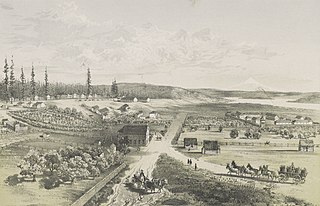
Fort Vancouver National Historic Site is a United States National Historic Site located in the states of Washington and Oregon. The National Historic Site consists of two units, one located on the site of Fort Vancouver in modern-day Vancouver, Washington; the other being the former residence of John McLoughlin in Oregon City, Oregon. The two sites were separately given national historic designation in the 1940s. The Fort Vancouver unit was designated a National Historic Site in 1961, and was combined with the McLoughlin House into a unit in 2003.

Clark College is a public community college in Vancouver, Washington. It is the largest institution of higher education in southwest Washington. Founded in 1933 as a private two-year, junior college, Clark College received its first accreditation in 1937 and has been accredited by the Northwest Commission on Colleges and Universities since 1948. It was incorporated into the statewide community college system in 1967.

The Columbian is a daily newspaper for Vancouver, Washington, and Clark County, Washington. The paper was published for its first decade (1890-1900) as a four-page daily that was meant as a counterweight to the local Republican newspaper The Independent. Printer Tom Carolan began publication of The Vancouver Columbian on October 10, 1890. It successfully hedged out daily competition, such as the former Independent, to become the sole daily in the city today. A former weekly The Sun which published for 39 years prior to going daily; was absorbed by the Columbian and for a time the paper was published as The Vancouver Columbian and the Sun. It has been owned by the Campbell family since 1921; current president and publisher Scott Campbell is the third generation of the family to run the paper. It is the newspaper of record for both Vancouver and Washougal.
Esther Clark Short was an early settler and founder of the City of Vancouver, Washington.

Vancouver is a city on the north bank of the Columbia River in the U.S. state of Washington. It is the largest suburb of Portland, Oregon. Incorporated in 1857, Vancouver had a population of 161,791 as of the 2010 U.S. census, making it the fourth-largest city in Washington state. Vancouver is the county seat of Clark County and forms part of the Portland-Vancouver metropolitan area, the 23rd largest metropolitan area in the United States. Originally established in 1825 around Fort Vancouver, a fur-trading outpost, the city is located on the Washington/Oregon border along the Columbia River, directly north of Portland. In 2005, Money magazine named it No. 91 on its list of best places in America to live. In 2016, WalletHub ranked Vancouver the 89th best place in the U.S. for families to live.
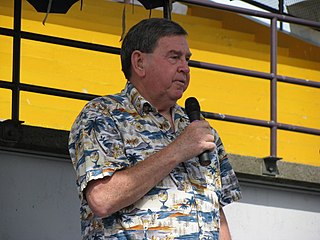
Royce Pollard was the six-term mayor of Vancouver, Washington. He served seven years on City Council and became mayor in 1996. He lost a reelection race to Tim Leavitt in 2010.
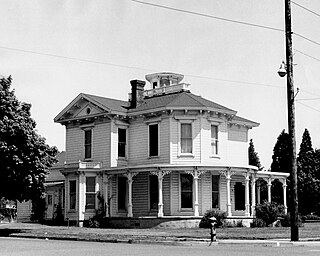
The Slocum House is a Victorian style house located in Vancouver, Washington, in the United States. The style also has been called Carpenter Victorian to emphasize both the vertical, Italianate features and the skill of craftsmanship, believed to be the work of Edward Slocum, brother of the owner. Ornamental medallions inside the house were signed and included patent dates from 1842 and 1846, although the house is believed by some to have been constructed in 1867. The 1867 date is not supported by local newspaper reports as there was no dwelling on the land at this time, and Charles W. Slocum was still busy in other areas of the Pacific Northwest. However many websites and reference books do mention the 1867 date, perhaps using a common source.
Charles W. Slocum was a prominent American pioneer businessman active in the Pacific Northwest.

The Pioneer Mother Memorial, also known as Pioneer Mother and Pioneer Mothers, is a 1928 bronze sculpture by American artist Avard Fairbanks, installed at Esther Short Park in Vancouver, Washington, in the United States. The memorial depicts a mother and three children, and commemorates pioneer mothers who settled in the Pacific Northwest. The main female figure may depict Esther Short, one of the first U.S. citizens to arrive in Fort Vancouver. Commissioned by Vancouver banker Edward Crawford and his wife Ida for $10,000, it is one of the city's oldest works of public art, acquired in 1928 and unveiled in 1929. The sculpture was renovated around the start of the 21st century and is maintained by the City of Vancouver's Parks & Recreation department.

The Vine is a bus rapid transit (BRT) route in Vancouver, Washington that is operated by C-Tran. The 6-mile-long (9.7 km) line runs from downtown Vancouver to the Vancouver Mall, serving 34 stations primarily on Fourth Plain Boulevard. It opened on January 8, 2017, becoming the first bus rapid transit system in the Portland metropolitan area.

Vancouver Waterfront Park is a 7.3-acre (3.0 ha) waterfront park in Vancouver, Washington, in the United States.
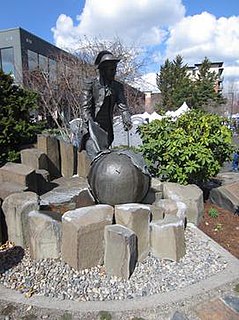
Captain George Vancouver is a 2000 bronze sculpture depicting George Vancouver by Jim Demetro, installed in Vancouver, Washington, United States. The statue, installed at the corner of Sixth and Esther streets near Esther Short Park, is 9 feet (2.7 m) tall and weighs approximately 1,500 lbs. It cost approximately $70,000 and was funded by private donors.

The Salmon Run Bell Tower is a bell tower and glockenspiel in Vancouver, Washington's Esther Short Park, in the United States.
Peter Crawford was a Scottish-born land surveyor who was a prominent pioneer in the Pacific Northwest. He founded Kelso, Washington and platted numerous towns in the Oregon Territory which later became the states of Oregon and Washington. He was a member of the Monticello Convention which petitioned and successfully convinced Congress to create Washington Territory out of the Oregon Territory.



















